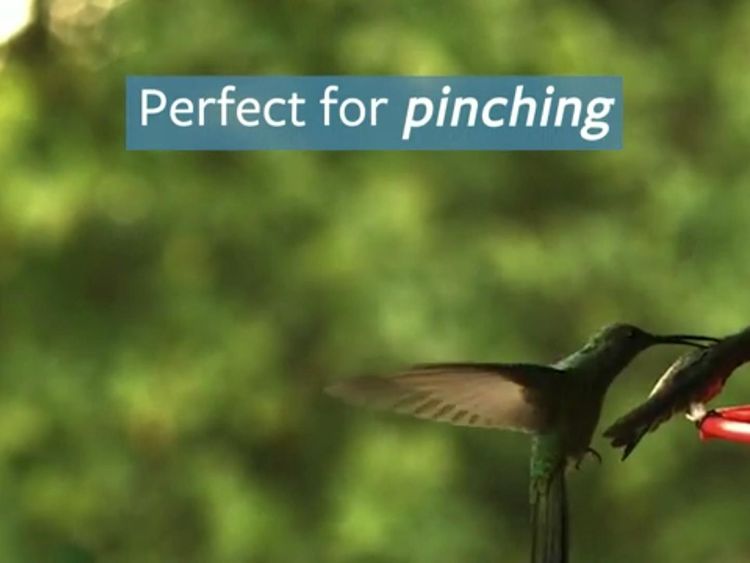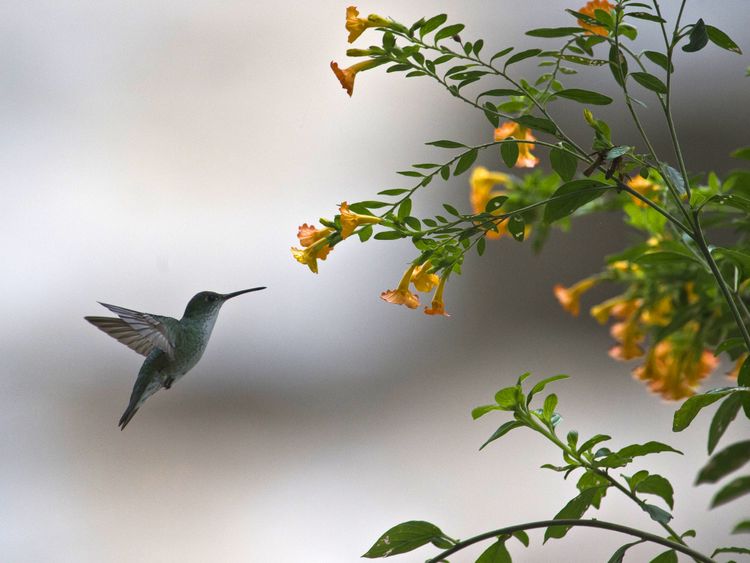Hummingbirds' bills and tongues have been exquisitely honed by evolution to feed on the nectar inside tropical South America's slender flowers.
But new research from the University of California, Berkeley, has spotted an adaptation emerging among some male hummingbirds.
A growing population appears to be evolving weaponised bills – beaks that are straighter and have teeth – making them less efficient feeders but more ferocious fighters.
Using high-speed video cameras, the scientists' have spotted male hummingbirds pulling at each other's feathers, pinching their skin, and wrestling rivals away from the best feeding spots.
For the first time, the researchers have captured hummingbirds' fencing and feeding strategies in slow motion, allowing them to assess the trade-offs between being optimised for fighting rather than feeding.
"We understand hummingbirds' lives as being all about drinking efficiently from flowers, but then suddenly we see these weird morphologies – stiff bills, hooks and serrations like teeth – that don't make any sense in terms of nectar collection efficiency," said Dr Alejandro Rico-Guevara, the lead scientist on the project from UC Berkeley.
"Looking at these bizarre bill tips, you would never expect that they're from a hummingbird or that they would be useful to squeeze the tongue," added Dr Rico-Guevara.

In some species of hummingbird, the females have curved bills which can easily slip inside the curved bells of flowers, but the males' beaks are straighter and better for poking – forcing them to feed on different flowers.
"It is all about feeding efficiency in flowers versus proficiency in fighting," Dr Rico-Guevara said.
The scientists acknowledged that hummingbirds have long been known as fierce fighters, with a reputation for attacking hawks, owls and other birds they perceive as a threat – but these fights happen so fast that scientists haven't been able to see the actual outcome.
"Because it happens so fast and they fly away, you can't track them," Dr Rico-Guevara said.
"But also, people haven't actually looked at the details of the beaks. We are making connections between how feisty they are, the beak morphology behind that and what that implies for their competitiveness."

After more than a decade of observing hummingbirds, Dr Rico-Guevara is publishing a paper explaining how the shape of their bills affect their feeding and fighting strategies in the journal Integrative Organismal Biology.
According to the research, the evolution of these extraordinary bills in tropical hummingbirds appears to be driven by increased competition – with up to five times more hummingbird species in every tropical habitat than there are elsewhere in the Americas.
"We have discovered that these traits may be related to a different kind of strategy: Instead of feeding on a particular flower shape very well, some birds try to exclude everybody from a patch of flowers, even though they can't feed as well on them as hummingbirds without bill weapons," Dr Rico-Guevara said.
"If you are good enough at keeping your competitors away, then it doesn't matter how well you use the resources in the flowers you are defending, you have them all to yourself."

And not all of the fighting hummingbirds use bills to protect their feeding spots, with others using them to out-fence rivals for the attention of females at gathering places called leks.
"A lek is like a singles bar, a place where many males get together and sing, sing, sing all the time," Dr Rico-Guevara explained.
More from Science & Tech
"The females go to these small spaces in the forest and pick a male to mate with. If you can get a seat at that bar, it is going to give you the opportunity to reproduce.
"So they don't fight for access to resources, like in the territorial species, but they actually fight for an opportunity to reproduce. And in the brief moments when there is no fighting, they go to feed on different flowers."
[contf] [contfnew] 
Sky News
[contfnewc] [contfnewc]







